April 3rd, 2024
As the weather warms up and gets sunny ☀️, children are outside more participating in sports and recreational activities ?♂️
As pediatric dentists, we highly promote the use of facial protection, such as mouth guards and helmets. But why may you ask?
There is a high chance of injury to your child's teeth and mouth during participation in sports and recreational activities! As dentists, we work hard to help families prevent these injuries as best as we can.
But of course, dental injuries unfortunately do happen quite often. If your child ever has an injury to their mouth, please contact to our child's dentist ASAP! We take dental injury emergencies very seriously and some injuries may be time sensitive to take care of.
A great resource that families can use is a phone app called ToothSOS (Disclaimer: we have no financial obligations to this application, it is just a great resource!). Families can easily pull up what injury their child has and follow the instructions on the app until they can reach their dentist.
Have fun and stay safe in the sun! ☀️ Don't forget to have your children wear mouthguards and helmets!!
January 3rd, 2024
New Year, new me?
With each new year comes new resolutions! We came up with a few to help you start off the year with great dental health for your child!
- Regular brushing routine: Our guidelines recommend that parents help their child brush 2x/day for 2 minutes each time. We know how hard it can be to do this, especially for our youngest patients. The most important thing is to establish a regular brushing routine - such as bath, brush, book, bed. Having a regular routine that your child can get used to brushing is much better than pushing for brushing 2x/day.
- Healthy food choices: It's always easy to say: "we have to eat healthier!" Healthy food choices doesn't have to mean no sugar, no sweets ever. What's more important is how often your child is consuming these sweet treats. Having the treat ocassionally as a dessert or special occasion is much healthier for your teeth than having it every day throughout the day. The more we expose our teeth to sugar, the more likely your teeth may develop cavities!
- Don't forget to see your dentist at least 2 times a year! Regular check ups not only have keep your child's mouth healthy and cavity free, this helps establish a healthy habit that your child will hold on to when they are adults. Children who had great experiences at the dentist as a child are more likely to continue to seek dental care when they are older!
We wish everyone a wonderful new year!
November 6th, 2023
Flossing is more than just a super cool dance move - Flossing is an important part of maintaining good oral hygiene, and it's especially important for children. While brushing is important for removing plaque and bacteria from the surfaces of the teeth, flossing is the only way to remove things from between the teeth.
Flossing should be started as soon as the child has teeth that are touching each other. This is usually around the age of 2-3 years old. Parents or caregivers should help their children floss to ensure that they are doing it properly. As the child grows older, they will be able to floss on their own.
Flossing may be difficult for some children, especially those with small mouths. In these cases, it may be helpful to use floss holders to make the flossing easier. Also, there's special floss picks made just for braces that make flossing much easier as well!
We understand that flossing can be a difficult habit to establish, but we are here to help with any questions you may have to help build healthy routines!
October 27th, 2022
It's time to celebrate Halloween but it doesn't have to be all about sweets!
Here are a few ideas of treats you can give to your child on Halloween to celebrate!
- Jack-o-lantern Fruit Cups: Fill a hollowed out orange peel with various types of cut up fruit (apples, pears, grapes - anything your child loves!). To make it more fun, cut out a jack-o-lantern face in the orange peel.
- Monster Apple Bites: Cut up slices of apples and fill with your child's favorite type of nut better (or alternative if your child has allergies). Then place a strawberry slice (for the monster's tongue), some type of seeds (for monster's teeth), and place some googly eyes! This makes for a fun "spooky" snack!
- Mini Mummy Pizzas: Make your child's lunch on Halloween pizza, with his/her favorite ingredients! To give the "mummy" look, place slices of cheese in horizontal lines before baking.
- Halloween Roasted Veggies: Make vegetables more fun by cutting them into fun Halloween shapes! Roast them in the oven for a healthy snack option.
These are just a few ideas on what you can do with your child. Just remember to make sure to brush your child's teeth after they have their sweet treat!
And don't forget, we are holding our annual Candy Buyback - your child can receive $1 per pound of candy they bring in (up to 5 lbs)!
March 11th, 2022
Why is flossing so important? We hear this all the time! Did you know that baby teeth are supposed to have space in between them? As your child grows, their teeth start to move closer together and touch tightly! When this happens, it’s important to start flossing. But why?
- Toothbrushes can’t clean in between teeth
- Food tends to get stuck between teeth when we eat and will stay there for a long time if not taken out, leading to cavities!
- Floss helps remove food, keeps the inner surfaces of our teeth clean, and prevent cavities!
It’s never too early to start flossing! (And we don’t only mean the fortnite dance :D)
February 28th, 2022
Parents really want to make sure that their children don't get cavities, but how do they help prevent the cavities?
- Have your child's first dental visit before the age of 1. This allows your child to have an established dental home to ensure they have the proper care.
- Take your child to the dentist regularly! We recommend taking your child to the dentist at least twice a year.
- Help your child brush 2x/day, 2 minutes each time.
- Give your child a balanced diet full of low-sugary foods.
We always want to do everything we can to prevent cavities and keep your child's smiles bright!
May 14th, 2021
Is your child in the stage where they are starting to drool a lot, they have the urge to bite everything, and you are starting to see little teeth come in? It's an exciting time! - your child is teething! We know teething can be extremely difficult and uncomfortable for some children, and it becomes a difficult time for the parents as well. Because we know how hard it is, here are some tips to help you and your family get through the teething process:
- Frozen towels - Wet a soft towel and place it into your freezer until the towel is cold but NOT frozen or hard. This is the safest and best option to have your child chew on! The towel is soft so that there is no harm to your child's mouth and the cold will help relieve their discomfort!
- Soft teething toys - Any teething toy that is soft in nature is great, such as the toys that you can throw into the freezer. Any toy works as long as it is soft. You want to avoid any hard plastic toys because they can easily break off and create a choking hazard for your child.
- Avoid teething medications - You want to avoid giving your child medications that are specifically for teething. The medications made for teething may not be at a healthy and safe level for your child. Avoid especially any topical ointments with anesthetic since it may not be safe for your child, such as Orajel. If needed, you can give your child Children's Tylenol to help with any fevers that come with teething.
Your dental family is always here to support you with any questions you may need! If you have any questions, please don't hesitate to ask!
December 29th, 2020
What's more exciting than seeing your child grow their first baby tooth? When your child gets their first loose tooth! It is finally time for your child to get a visit from the tooth fairy. But you also notice that the new tooth is growing behind their baby tooth. Many parents come ask us - "is this something we need to worry about?" The great news is, this is extremely common! We call this "Shark Teeth." Shark teeth is when the new adult teeth grow in a row behind the existing baby teeth, creating two rows of teeth, similar to sharks!
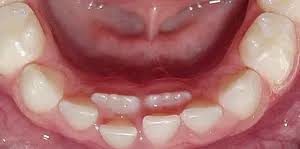
Most of the time, we don't have to worry about shark teeth. Once the baby tooth falls out, the new adult tooth will drift into the space, even though it has grown in behind the other tooth. The normal movement and pressure from your child's tongue will also allow the tooth to be pushed into place - your child doesn't have to actively push on the tooth with their tongue!
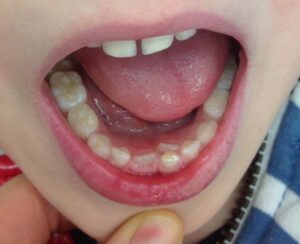
When might we worry? If you notice that your child's new adult teeth have now grown taller than your child's baby teeth, and you also notice that the baby teeth are not loose, this is a great to talk to your child's dentist. Your dentist will be able to evaluate your child to determine if there is anything that needs to be done in order for your child's teeth to grow in properly.
When in doubt, never hesitate to ask your dentist! They are your experts on oral health and always want to make sure that you and your family are well taken care of.
December 7th, 2020
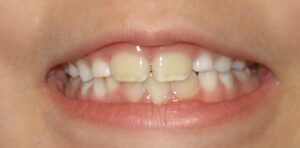
As children start losing their baby teeth and their new adult teeth come in, a lot of parents ask, "why are their new teeth yellow?" and "is this something we should be worried about?" These are great questions! First off, this is definitely nothing to worry about! Adult teeth are naturally more yellow in color than baby teeth, and here are the reasons why:
- Every tooth is made up of layers: an outer 'white' layer (enamel), an inner 'yellow' layer (dentin), and the innermost layer containing blood vessels and nerves (pulp). Baby teeth and adult teeth look different based on the amount of thickness of the layers of enamel and dentin!
- Baby teeth have thin layers of dentin, meaning less of the 'yellow' layer. The enamel in baby teeth is also more opaque, making it harder to see the yellow layer through the white. All of this together makes baby teeth look super bright and white!
- Adult teeth have a thicker dentin layer, meaning more 'yellow.' The enamel is also semi-translucent, allowing the yellow color underneath to show through more easily. This allows adult teeth to be more yellow in color.
One last question you may have is: "can we do anything about the yellow teeth?"
- We don't recommend teeth whitening in office or at home whitening kits for young children. These products can make teeth extremely sensitive and uncomfortable for your child.
- Also, if your child has a mixture of baby teeth and adult teeth currently in the mouth, there are still more adult teeth to come in to replace those baby teeth. If you choose to whiten teeth at this time, the new set of adult teeth coming in will be a different color - you won't be able to specifically whiten the new teeth to match the old ones!
- Once a child has all of their adult teeth in their late teenage years, we can go over different safe methods of whitening their teeth to reduce the chances of sensitivity and to keep their teeth healthy.
So are yellow teeth bad? Not at all! We always want to emphasize the importance of strong and healthy teeth is by not having any cavities - not the color of the teeth. Having white teeth doesn't always mean a tooth is healthy!
September 23rd, 2020
With sports resuming, we wanted to turn our attention to a topic that's not discussed as often - Mouthguards! What are mouthguards you may ask? These are also known as mouth protectors because they help cushion any injury to the face. Wearing a mouthguard minimizes the risk of broken teeth and injury to lips, tongue, face, and jaw. The teeth we are most concerned about are the upper front teeth. The lower teeth are more protected because they are further back, but your upper teeth are front and center to any injury to the face! Lost of your child's front teeth may affect the way they smile, talk, and eat. By preventing these injuries, we can protect your child's beautiful smile!
A mouthguard should be worn as part of the athletic gear of the sport that they play. Did you know that dental injury was most common during baseball in children aged 7-12 years and during basketball in children aged 13-17 years? These higher collision and contact sports increase the risk for injury!
The best type of mouthguard is one that is custom made for your child by a dentist. The mouthguard is made specifically from a mold of your child's mouth so that it fits nice and snug. You can also purchase a mouthguard from any drug store, known as a boil-and-bite mouthguard. These mouthguards are softened in boiled water, then inserted to your child's mouth to allow it to adapt to the shape of their mouth. They do not have the perfect fit of a custom mouthguard, but will still be able to protect your child's mouth! Lastly, there are stock mouthguards also found in drug stores that are inexpensive and come preformed and ready to wear. The only downside to this type of mouthguard is that they don't fit very well, may be bulky and makes breathing and talking very difficult.

In addition, if your child has braces, a mouthguard becomes even more important! Any injury to the face may not only cause damage to the teeth but also to the orthodontic appliances that may end up injurying your child's gums and cheeks.
You should always work with your dentist regarding choosing the right mouthguard for your child. As your child grows, they may need to switch mouthguards to adapt to the growth of their jaws! In addition, keeping their mouthguard clean is as important as brushing their teeth - we don't want any infections to start from bacteria growing inside the mouthguard.
Let's work together as a team to help maintain your child's smile!
July 21st, 2020
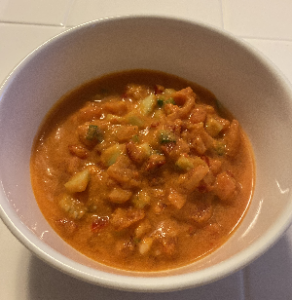
It's summer time! The sun is out and the weather is heating up. What better way to cool down than with a cool refreshing recipe that will be fun to make for your kids? It's always hard to get children to eat more vegetables, but this veggie packed soup will allow you to sneak in all the nutrients that are great for your child!
Crunchy vegetables are the best for your child's teeth! As they chew, the hard texture will help prevent things from sticking to their teeth, making it less likely for your child to get cavities. Of course, this doesn't mean that they don't have to brush - we don't like having things stick to our teeth!
Also, if your child is a picky eater, this soup gives new sensations that will make it fun to eat! It's colorful from the different vegetables, it has crunchy and soft textures, and best of all - it's a soup that's cold! We hope this simple recipe brings some fun into your kitchen!
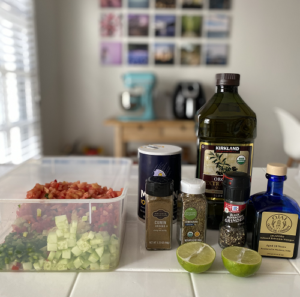
Summer Gazpacho
Prep time: 30 minutes
Total time: 2 hour 30 minutes
Servings: 6
Ingredients
- 4 large fresh tomatoes, peeled and diced (or 8 small fresh tomatoes)
- 1 pint cherry tomatoes (or 2 small fresh tomatoes)
- 1 cucumber, peeled and diced
- 1 red bell pepper, seeded and diced
- 1 jalapeno pepper, seeded and diced (can substitute for a green bell pepper if you do not want any spiciness)
- 2 cloves garlic, minced
- 1 teaspoon salt
- 1/2 teaspoon ground cumin
- 1 teaspoon dried oregano
- freshly ground black pepper to taste
- 1/4 cup extra-virgin olive oil
- 1 lime, juiced
- 1 tablespoon balsamic vinegar
- 2 tablespoons thinly sliced fresh basil
Directions
- Combine diced tomatoes, cucumber, bell pepper, jalapeno, and garlic in a large bowl. Stir in salt, cumin, oregano, and black pepper.
- Place cherry tomatoes, olive oil, lime juice, and balsamic vinegar in a blender. Cover and puree until smooth. Pour pureed mixture into the tomato-cucumber mixture. Stir to combine.
- Place 1/3 of the tomato mixture back into the blender. Cover and puree until smooth. Return pureed mixture to the remaining tomato mixture. Stir to cobine.
- Cover and chill in the refrigerator for 2 hours.
- Season cold soup with salt and black pepper to taste. Top with fresh basil. Enjoy!
Visit our Instagram page for an short instructional video of this recipe!
July 10th, 2020
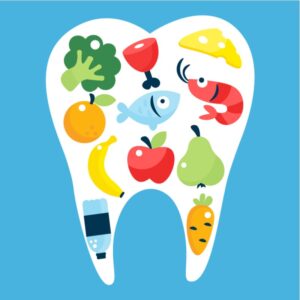
In order to make sure the food your child eats is good for their teeth, make sure they have a balanced diet! Include fruits and vegetables, breads and cereals, milk and dairy products, and meat, fish and eggs. In addition, you want to limit the servings of sugars and starches that your child eats to protect their teeth from cavities. We are never saying "no sugar" or "no candy" ever! The most important thing is everything in moderation - it has to be balanced!
Let's talk about the foods that are the BEST for your child's teeth:
- Fiber-rich fruits and vegetables
- Foods with fiber help keep your teeth and gums clean!
- They also get your saliva flowing - increasing amount of saliva in your mouth helps to reduce the effect of any acid that can attack teeth and start cavities. Saliva also helps to restore the essential minerals to teeth.
- Cheese, milk, plain yogurt
- The calcium in dairy products help to put minerals back in your teeth where they have been lost and helps to rebuild tooth enamel, the protective layer of your teeth!
Now what about the foods that can be bad for your child's teeth:
- Sticky candies and sweets
- The bacteria that live in our mouths love sugar! They use this sugar to produce an acid that breaks down your teeth, causing cavities!
- Sticky candies love those deep grooves in your teeth and they stick there really well if you don't brush! The longer the candy stays on the tooth, the higher chance of getting a cavity!
- If you were to choose a sweet to eat, chocolate would be the best! It melts in your mouth and doesn't stay there like the sticky candies do!
- Starchy foods such as cookies and crackers
- These soft foods become sticky after they are chewed and stick to your teeth just as how sticky sweets would!
- Carbonated soft drinks
- Not only do these drinks contain a lot of sugar, it is also very acidic that can contribute to wearing away at your tooth enamel, the protective layer of your teeth!
Here's our recommendations (based on recommendations from the American Dental Association):
- Have your child eat sugary foods with meals, reducing the amount of time the sugar stays in your child's mouth! During meals, more saliva is produced, washing away pieces of food that can stay in the mouth.
- Limit between-meal snacks. As mentioned before, we don't want foods to be stuck in our teeth for a long time! If your child wants a snack, give them something nutritious, like fruit or veggies.
- Drink more water! Replace soda and juices with plain water.
- Always remember to help your child brush and floss 2x/day!
Remember - there's no right or wrong thing to eat, it's all about moderation. Make sure to eat balanced meals!








